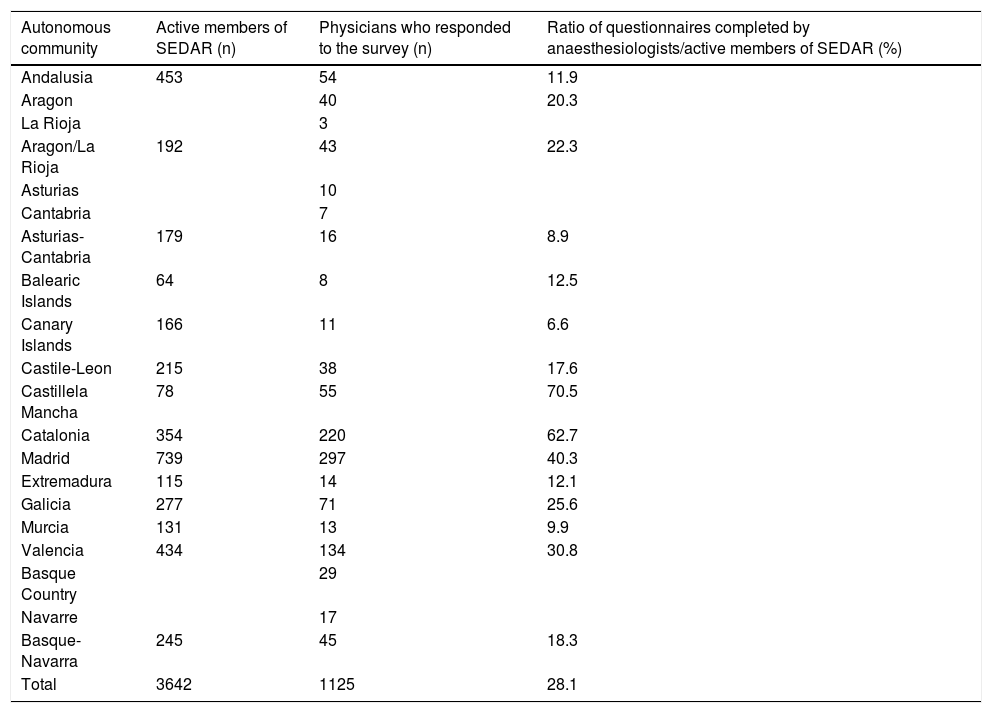We explored the experience of clinicians from the Spanish Society of Anesthesiology (SEDAR) in airway management of COVID-19 patients.
MethodsAn software-based survey including a 32-item questionnaire was conducted from April 18 to May 17, 2020. Participants who have been involved in tracheal intubations in patients with suspected or confirmed COVID-19 infection were included anonymously after obtaining their informed consent. The primary outcome was the preferred airway device for tracheal intubation. Secondary outcomes included the variations in clinical practice including the preferred video laryngoscope, plans for difficult airway management, and personal protective equipment.
Results1125 physicians completed the questionnaire with a response rate of 40,9%. Most participants worked in public hospitals and were anesthesiologists.
The preferred device for intubation was the video laryngoscope (5.1/6), with the type of device in decreasing order as follows: Glidescope, C-MAC, Airtraq, McGrath and King Vision. The most frequently used device for intubation was the video laryngoscope (70,5%), using them in descending order as follow: the Airtraq, C-MAC, Glidescope, McGrath and King Vision.
Discomfort of intubating wearing personal protective equipment and the frequency of breaching a security step was statistically significant, increasing the risk of cross infection between patients and healthcare workers. The opinion of senior doctors differed from younger physicians in the type of video-laryngoscope used, the number of experts involved in tracheal intubation and the reason that caused more stress during the airway management.
ConclusionsMost physicians preferred using a video-laryngoscope with remote monitor and disposable Macintosh blade, using the Frova guide.
Analizamos la experiencia de médicos de la Sociedad Española de Anestesiología (SEDAR) en el manejo de vía aérea de pacientes COVID-19.
MétodosSe realizó una encuesta que incluía 32 ítems (18 abril-17 mayo de 2020). Participaron de forma anónima tras aceptar el consentimiento informado médicos involucrados en intubaciones traqueales en pacientes COVID-19 confirmados o con sospecha. El resultado principal fue el dispositivo de vía aérea preferido para la intubación traqueal. Los resultados secundarios incluyeron el análisis de la práctica clínica, el videolaringoscopio preferido, manejo de vía aérea difícil y uso de equipo de protección personal.
ResultadosCompletaron el cuestionario 1125 médicos (tasa de respuesta del 40,9%) que eran mayoritariamente anestesiólogos y trabajaban en hospitales públicos.
El dispositivo preferido para intubar fue el videolaringoscopio (5.1/6) con el siguiente orden de preferencia: Glidescope, C-MAC, Airtraq, McGrath y King Vision. El dispositivo de intubación más utilizado fue el videolaringoscopio (70,5%) con el siguiente orden decreciente: Airtraq, C-MAC, Glidescope, McGrath y King Vision.
La relación de incomodidad de la intubación con equipo de protección personal y la frecuencia de incumplimiento de un paso de seguridad fue estadísticamente significativa, aumentando el riesgo de infección cruzada. La opinión de los médicos senior difería de los más jóvenes en el videolaringoscopio utilizado, número de expertos involucrados en la intubación traqueal y la razón que provocó más estrés durante el manejo de la vía aérea.
ConclusionesLa mayoría de los médicos prefirieron usar un videolaringoscopio con monitor remoto y hoja Macintosh desechable, usando la guía Frova.
















